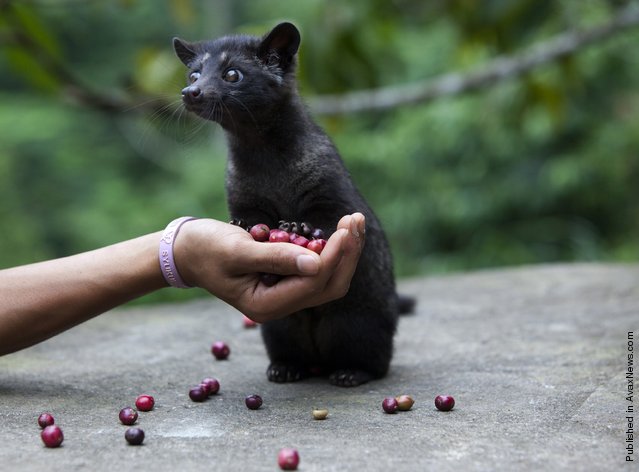
Photo: A four month old Luwak is tempted by some red coffee beans at the BAS Coffee plantation January 20, 2011 in Tapaksiring, Bali, Indonesia. The Luwak coffee is known as the most expensive coffee in the world because of the way the beans are processed and the limited supply. The Luwak is an Asian palm civet, which looks like a cross between a cat and a ferret. The civet climbs the coffee trees to find the best berries, eats them, and eventually the coffee beans come out in its stools as a complete bean. Coffee farmers then harvest the civet droppings and take the beans to a processing plant. Luwak coffee is produced mainly on the islands of Sumatra, Java, Bali and Sulawesi in the Indonesian Archipelago, and also in the Philippines. (Photo by Paula Bronstein /Getty Images)
“Kopi luwak (Malay pronunciation), or civet coffee, is one of the world's most expensive and low-production coffee. It is made from the beans of coffee berries which have been eaten by the Asian Palm Civet (Paradoxurus hermaphroditus) and other related civets, then passed through its digestive tract. A civet eats the berries for their fleshy pulp. In its stomach, proteolytic enzymes seep into the beans, making shorter peptides and more free amino acids. Passing through a civet's intestines the beans are then defecated, keeping their shape. After gathering, thorough washing, sun drying, light roasting and brewing, these beans yield an aromatic coffee with much less bitterness, widely noted as the most expensive coffee in the world.
Kopi luwak is produced mainly on the islands of Sumatra, Java, Bali and Sulawesi in the Indonesian Archipelago, and also in the Philippines (where the product is called motit coffee in the Cordillera and kape alamid in Tagalog areas) and also in East Timor (where it is called kafé-laku). Weasel coffee is a loose English translation of its name cà phê Chồn in Vietnam, where popular, chemically simulated versions are also produced.
The origin of Kopi Luwak is closely connected with the history of Coffee production in Indonesia. In early 18th century The Dutch established the cash-crop plantations in their colony in Dutch East Indies islands of Java and Sumatra, including Arabica coffee introduced from Yemen. During the era of Cultuurstelsel (1830—1870), the Dutch prohibited the native farmers and native plantation workers to pick coffee fruits for their own use. Yet the native farmers desired to have a taste of the famed coffee beverage. Soon the natives learned that certain species of musang or luwak (Asian Palm Civet) consumed these coffee fruits, yet they left the coffee seeds undigested in their droppings. The natives collect these Luwak's dropping coffee seeds; clean, roast and grind it to make coffee beverage. The fame of aromatic civet coffee spread from locals to Dutch plantation owners and soon become their favourites, yet because of its rarity and unusual process, the civet coffee was expensive even in colonial times”. – Wikipedia
Kopi luwak is produced mainly on the islands of Sumatra, Java, Bali and Sulawesi in the Indonesian Archipelago, and also in the Philippines (where the product is called motit coffee in the Cordillera and kape alamid in Tagalog areas) and also in East Timor (where it is called kafé-laku). Weasel coffee is a loose English translation of its name cà phê Chồn in Vietnam, where popular, chemically simulated versions are also produced.
The origin of Kopi Luwak is closely connected with the history of Coffee production in Indonesia. In early 18th century The Dutch established the cash-crop plantations in their colony in Dutch East Indies islands of Java and Sumatra, including Arabica coffee introduced from Yemen. During the era of Cultuurstelsel (1830—1870), the Dutch prohibited the native farmers and native plantation workers to pick coffee fruits for their own use. Yet the native farmers desired to have a taste of the famed coffee beverage. Soon the natives learned that certain species of musang or luwak (Asian Palm Civet) consumed these coffee fruits, yet they left the coffee seeds undigested in their droppings. The natives collect these Luwak's dropping coffee seeds; clean, roast and grind it to make coffee beverage. The fame of aromatic civet coffee spread from locals to Dutch plantation owners and soon become their favourites, yet because of its rarity and unusual process, the civet coffee was expensive even in colonial times”. – Wikipedia
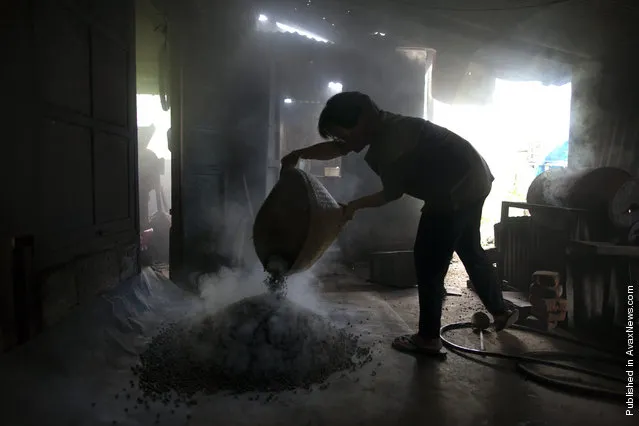
PUPUAN, BALI, INDONESIA -JANUARY 20: Steam rises as Sari Artini pours freshly roasted beans onto the floor January 20, 2011 in Pupuan village, Bali, Indonesia. Sari Artini and her husband Wayan Dira have had a small coffee business for the last two years in the coffee region of western Bali. They own nine Luwaks and are now producing the expensive coffee hoping to cash in on the desire for the rare beans. The Luwak coffee is known as the most expensive coffee in the world because of the way the beans are processed and the limited supply. The Luwak is an Asian palm civet, which looks like a cross between a cat and a ferret. The civet climbs the coffee trees to find the best berries, eats them, and eventually the coffee beans come out in its stools as a complete bean. Coffee farmers then harvest the civet droppings and take the beans to a processing plant. Luwak coffee is produced mainly on the islands of Sumatra, Java, Bali and Sulawesi in the Indonesian Archipelago, and also in the Philippines. (Photo by Paula Bronstein /Getty Images)
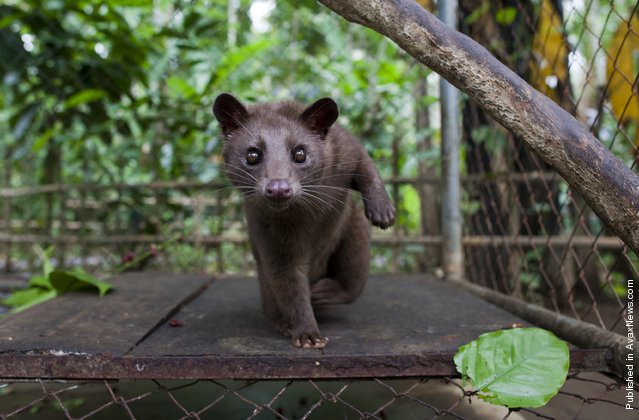
A Luwak is kept in a cage so that tourists can view the animal at the Abian Sari coffee plantation January 20, 2011 in Tapaksiring village, Bali, Indonesia. (Photo by Paula Bronstein /Getty Images)
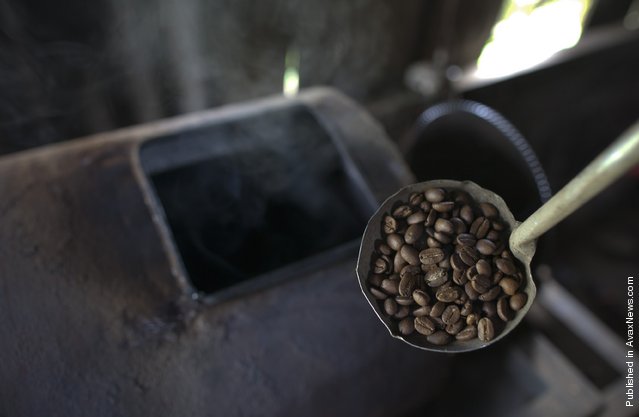
PUPUAN, BALI, INDONESIA -JANUARY 20: Wayan Dira checks on Luwak beans that have just been roasted January 20, 2011 in Pupuan village, Bali, Indonesia. (Photo by Paula Bronstein /Getty Images)
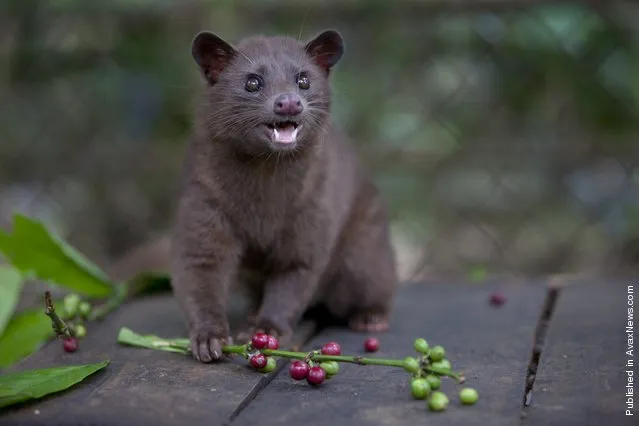
A Luwak snacks on coffee berries inside its cage January 16, 2011 in Bali, Indonesia. (Photo by Paula Bronstein /Getty Images)

Wayan Dira picks robusta coffee beans on his plantation January 20, 2011 in Pupuan village, Bali, Indonesia. (Photo by Paula Bronstein /Getty Images)
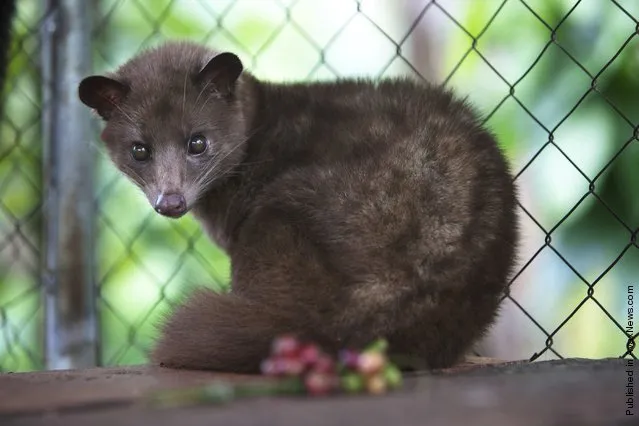
A Luwak sits in its cageJanuary 16, 2011 in Bali, Indonesia. The Luwak coffee is known as the most expensive coffee in the world because of the way the beans are processed and the limited supply. The Luwak is an Asian palm civet, which looks like a cross between a cat and a ferret. The civet climbs the coffee trees to find the best berries, eats them, and eventually the coffee beans come out in its stools as a complete bean. Coffee farmers then harvest the civet droppings and take the beans to a processing plant. Luwak coffee is produced mainly on the islands of Sumatra, Java, Bali and Sulawesi in the Indonesian Archipelago, and also in the Philippines. (Photo by Paula Bronstein /Getty Images)
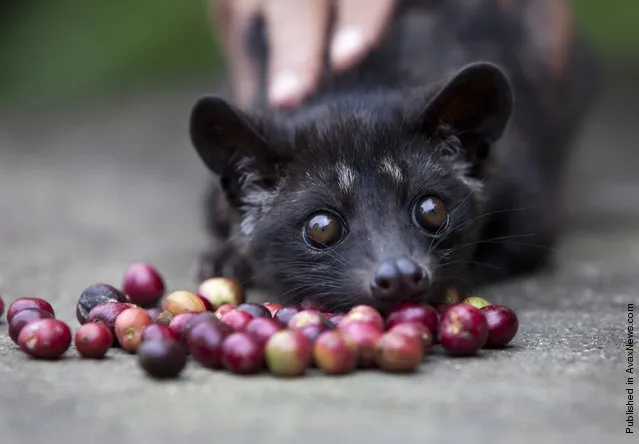
A four month old Luwak is tempted by some red coffee beans at the BAS Coffee plantation January 20, 2011 in Tapaksiring, Bali, Indonesia. (Photo by Paula Bronstein /Getty Images)
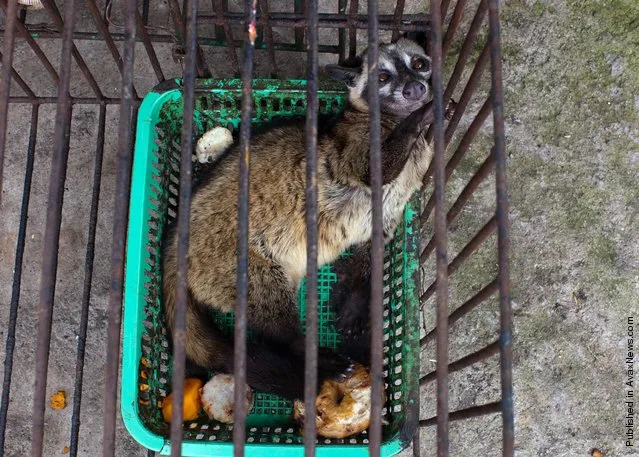
A Luwak is kept in a small cage and never allowed out being fed coffee beans once a day January 20, 2011 in Pupuan village, Bali, Indonesia. (Photo by Paula Bronstein /Getty Images)
19 Mar 2011 18:41:00,
post received
0 comments
